- Home
- David R. George III
Star Trek: The Fall: Revelation and Dust Page 2
Star Trek: The Fall: Revelation and Dust Read online
Page 2
One
Captain Ro Laren waited uneasily atop a bluff that overlooked the rolling parkland below. She glanced down at the lush vista, at the walking paths that rose and fell throughout, at the stands of trees and arrays of colorful flowers. A gentle breeze wisped past, carrying with it fresh scents, including the crisp hint of water.
Ro peered down briefly at the small lake off to her right, then cast her gaze in the opposite direction. Atop the highest point in sight, Prynn Tenmei stepped toward the edge of a promontory. The lieutenant wore not her Starfleet uniform, but a formfitting lavender flight suit that contrasted dramatically with her porcelain complexion. Her jet hair—which, though not long, typically rose in wild kinks from her scalp—had been pulled back and gathered into a small bun.
Anxiety mounted in Ro as she watched Tenmei. The lieutenant stood ramrod straight, her arms tucked behind her back. With a quick motion, Tenmei suddenly took one more pace forward, to the brink of the stony outcropping, and then flung herself headlong into the open air.
Tenmei fell in a graceful arc, but at a rate noticeably slower than normal. Even so, she descended fast enough to injure herself—seriously, even fatally—if she struck the ground. Ro knew that couldn’t happen, that local sensors would detect an impending accident and trigger an automatic transport to safety, but she still tensed watching Tenmei plunge toward the park.
Seconds seemed to elongate, and the captain consciously stopped herself from clenching her hands into fists as Tenmei drew uncomfortably close to the ground. When the lieutenant reached a height of perhaps ten meters—surely close to the sensors’ safety limit—Ro expected her to vanish in a blur of white transporter light. At that instant, though, Tenmei thrust her arms out to her sides and waved them downward. The gossamer wings she wore swelled as they caught the air. Her descent slowed, and when she flapped her arms once, twice, her course curved upward. She banked to one side and described a fluid turn, fluttering her wings to gain altitude.
The susurrus of distant applause reached Ro. Satisfied that Tenmei controlled her flight, the captain looked away from Defiant’s primary conn officer and about the park. Around the tree-lined base of the half-dome–shaped enclosure, and interspersed along the footpaths and up and down the knolls, hundreds of her crew had congregated. Although still five days away from the station’s formal dedication and its transition to full operational status, Ro had made the decision to conduct a small celebration ahead of time, exclusively for the complement of the new Deep Space 9.
A grand amalgam of engineering and nature, of technology and beauty, the park occupied an arc of the station’s primary section, a central sphere. In addition to its use as a place for the crew’s recreation, it served as a functioning part of DS9’s life-support systems. Soil and stone and flora had been imported from Bajor to create the undulating, grass-covered hills, with rocky elevations rising up along about a quarter of the perimeter. Above, a simulated blue sky crowned the locale, although as the internal environment of the station progressed into the nighttime portion of its virtual twenty-six-hour day, the holographic morning and subsequent afternoon would fade, and the stars would become visible through the transparent hull overhead. The park had been intentionally positioned away from the three perpendicularly intersecting rings that encircled DS9’s main sphere, thereby affording evening visitors to the picturesque setting an unimpeded view of the nocturnal sky.
Ro wondered what that view would look like if the wormhole ever sprung back to life. The station had been oriented in such a way that the spectacle would be visible from the park. It had been nearly two years, though, since the events that had collapsed the wormhole, and although the official Bajoran position maintained that the Celestial Temple endured and would one day reappear, Federation scientists had so far been unable to detect any indication of its continued existence. The captain also knew that the design and construction of DS9 allowed for the capability to move the station safely from the Denorios Belt to the orbit of Bajor, should that become politically acceptable to the first minister and her people.
Lieutenant Tenmei completed three circuits above the park, occasionally flapping her wings as she glided easily through the elevated, low-gravity envelope that facilitated her flight. Finally, she alit opposite the location from where she’d begun, setting down in one of four designated landing zones, where the field of reduced gravity situated above the park reached all the way to the ground. Once more, a round of applause went up.
The captain saw several crew members approach Tenmei, while others disbursed throughout the park. The lieutenant’s flight—the first on the station, outside of testing—concluded the brief ceremony, which Ro had begun with a few words via her communicator to those assembled. She’d congratulated and thanked them for all their efforts during the previous twenty-three months. After the destruction of the original Deep Space 9, most of the surviving crew had stayed on, some on Bajor, some on the various starships that had patrolled the system, and some alternating between the two. Starfleet had quickly renovated an abandoned planetside transportation center, converting it into a place dubbed Bajoran Space Central, which helped substitute for some of DS9’s lost services while awaiting completion of the new station. Other services had required the use of orbital tenders, while still others had been undertaken by the crews of several Starfleet vessels.
In Ro’s remarks, she had chosen not to mention those who had perished with the first Deep Space 9. When rogue elements of the Typhon Pact—along with an Andorian Starfleet officer dispirited both by his people’s ongoing reproductive crisis and by their secession from the United Federation of Planets—had attacked and demolished the station, eleven hundred UFP citizens had died, a majority of them Starfleet personnel, and all of them Ro’s responsibility. The captain had not forgotten any of that, nor did she think she ever could, but in addressing her crew that morning, she’d wanted to focus on the positive as the Corps of Engineers released the final section of the new DS9—its park—for use. She intended to repeat her comments thirteen hours later, at the other end of the day, to ensure that, no matter the shift on which they served, every member of her crew—nearly twenty-five hundred strong on the massive station—would have the opportunity to attend. Ro also planned to host a memorial for her crew on the day before the dedication. Moreover, she would honor the fallen at the dedication ceremony, and felt sure that she would not be the only one of the speakers to do so.
“Impressive,” said one of the two people standing beside Ro. The captain turned toward Rakena Garan, castellan of the Cardassian Union. The woman owned a delicate figure, not much taller than a meter and a half, but she bore her status as the elected leader of her people with power and intensity.
Although noteworthy for Ro to be in the presence of an important political leader, it pleased the captain that it no longer discomfited her to stand beside a Cardassian. It had been more than a decade and a half since the end of the Occupation, and nearly three years since the Union had joined the Federation, the Klingon Empire, and the Ferengi Alliance in the Khitomer Accords, and it seemed as though the old hatreds had begun to fade, perhaps even replaced with a ration of forgiveness. It also helped that for the previous two years, a member of the Cardassian Guard, Zivan Slaine, had served as a member of Ro’s crew, and that she had done so admirably well. Holding the Guard’s rank of dalin, roughly equivalent to a lieutenant commander in Starfleet, Slaine served DS9 as a tactical officer.
“That was indeed impressive,” agreed Asarem Wadeen, the first minister of Bajor. “I’ve always wanted to fly.” Although only a dozen or so centimeters taller than the castellan, Asarem had a toned, almost muscular physique, and so seemed even more imposing than her Cardassian counterpart. Like Garan, the first minister exuded charisma, a quality that, if not a definite prerequisite for elective office, Ro figured must certainly prove useful for politicians pursuing leadership posts. Though the captain stood taller than both women and had earned her own position of auth
ority, she held no illusions about their relative bearings; Ro commanded the loyalty and respect of her crew, but that hardly equated to having hundreds of millions of people willfully select her as their head of state.
“If you’d like,” Ro told Asarem, “it wouldn’t take long for the replicator to fit you for a pair of wings.”
Asarem lifted her eyebrows in an expression of interest, but then glanced over her shoulder. Ro followed her gaze. Past Asarem’s chief of staff, a woman named Enkar Sirsy, and Garan’s aide, a man named Onar Throk, two sets of attentive, stone-faced men and women—one pair Cardassian, the other Bajoran—stood like coiled springs, tensed and ready to leap forward. If there’s one thing that all sentient species have in common, Ro thought, it’s the steely look of their security personnel.
“I don’t think my protective detail would appreciate me leaping from high places into midair,” Asarem said, “no matter what tricks you play with gravity.”
“I’m sure you’re right,” Ro said. “Should we continue your tour of the station, then?”
Both the first minister and the castellan agreed, and Ro led them down the gentle slope leading from the bluff. The aides and the security detachments fell in around them, both clusters of personnel already aware of the day’s schedule. The group reached the tree line, which masked the bulkhead enclosing the park at “ground” level. A pair of large, thick metal doors opened at their approach, revealing the corridor beyond—a corridor that, although wider and taller, put Ro in mind of those aboard the starships on which she’d served. She appreciated DS9’s spacious, brightly illuminated passages, which she considered substantial upgrades over those of its Cardassian-constructed predecessor, with their narrow, low-ceilinged dimensions and murky lighting. Where the previous station had reflected the oppressive sensibilities of its slavedriving builders, lending the entire facility a claustrophobic air, the new structure had clearly been designed as a comfortable place for people to live, work, and visit.
Ro crossed to a turbolift, its doors parting in front of her. Two of the security officers, one Bajoran and one Cardassian, entered the cab ahead of First Minister Asarem, Castellan Garan, their aides, and Captain Ro, and the other two escorts trailed the group inside. As with the corridors on the new station, the lifts improved upon those they replaced: well lighted, very roomy, and quiet. Ro specified their destination, and the cab immediately began to descend.
“The station looks very different from the last time I saw it,” said Asarem. “It’s amazing how much work has been done since then.” The first minister had previously visited Deep Space 9 a year into its construction, by which time the installation of its first two fusion reactors had rendered almost half of its interior habitable, and after some members of Ro’s crew had relocated there; the captain herself had divided her time between DS9 and Bajoran Space Central.
In the intervening eleven months, while Chief O’Brien and Lieutenant Commander Nog led the Starfleet Corps of Engineers in completing the station, Ro and her staff had begun familiarizing themselves with their new home. Eventually, even as construction continued, they initiated partial operations, mostly as a staging area for the routing of aid and other goods to Cardassia. The DS9 crew also started processing some imports and exports to and from Bajor, as well as handling some travelers headed for the planet. All that work and more continued to be supplemented by the efforts of the personnel at Bajoran Space Central and aboard the remaining Starfleet vessels—Defiant and Robinson—assigned to patrol the system. Upon becoming fully operational, the station crew would undertake all of those duties in their entirety, as well as assuming increased freight and passenger services, not just for Bajor, but for the greater region.
Deep Space 9 would also function as a full-fledged starbase. It would provide maintenance, repair, and support for starships in the sector and beyond, and its advanced scientific and medical laboratories would help sustain research. Starfleet Command also intended to utilize the station as a platform from which to stage exploratory missions out beyond the Bajoran system. Despite the absence of the wormhole and the corresponding lack of ready access to the Gamma Quadrant, Bajor still floated on the outer reaches of known space. With respect to matériel, Starfleet had almost completely recovered from the Borg invasion four and a half years earlier. Although the ranks of the Federation’s space service had been depleted of legions of experienced officers, five Academy classes had graduated since then, and the number of fresh recruits continued to swell. With new allies in the Cardassian Union and the Ferengi Alliance, and with two years of relative peace among the nations of the Khitomer Accords and the Typhon Pact, Starfleet had recently renewed its commitment to voyages of discovery. It pleased Ro to know that her Deep Space 9 crew would constitute a major supporting component of those efforts.
“It also seems considerably larger than any Cardassian stations I’ve been to,” Garan noted.
“At the moment, it’s the largest deep-space starbase Starfleet has ever built,” Ro confirmed, revealing nothing not observable to anybody with even a rudimentary knowledge of Starfleet’s remote stations, which surely the castellan possessed. “At normal capacity, we can support a total population of thirteen thousand, not including the crews and passengers present on any ships docked at the station.”
“How many vessels can you accommodate at one time?” Asarem asked.
“Each of the station’s rings is composed primarily of docking facilities, cargo holds, and repair bays,” Ro said. “Depending on the size of the ships, we can directly support dozens at a time.” Again, she related only obvious information. The captain did not mention the sensor arrays, shield generators, or weapons ports also housed in the rings, though DS9’s sphere also boasted defensive and offensive systems. The starbase, she knew, had been conceived not only to replace and improve upon its antecedent in terms of its basic functions, but also to stand as a veritable fortress in the Bajoran system.
“Even though a number of the crew have been here for almost a year,” Ro added, “we’re still getting to know the station.” Those efforts had grown increasingly hectic of late, since the Starfleet Corps of Engineers had finished the starbase an entire month ahead of schedule. Among other repercussions of that early delivery, the dedication ceremony had been moved up to coincide with the two-year anniversary of the original DS9’s destruction.
I have to remember to thank and dress down Chief O’Brien for that, Ro thought archly. After the loss of the first DS9, the engineer had been transferred to the Bajoran system to lead the design and construction of its replacement. Going forward, he would serve as the station’s chief engineer, with Lieutenant Commander Nog as his right hand.
The turbolift slowed to a halt, and its doors opened to reveal another large compartment, though not quite so considerable as the station’s park. Ro led the group out of the cab, into a large atrium, one of four evenly laid out around that level. Public benches lined the space, and artwork of varying origin decorated the bulkheads. In the center of the area stood a black pyramidal base, above which hung a translucent holographic image of Deep Space 9, projected in three dimensions. Ro crossed the atrium toward the outer surface of the sphere.
“Welcome to the Plaza,” she said, spreading her arms wide to take in the broad, three-story-tall concourses that stretched away from the atrium to the left and right, hugging the curvature of the hull. Along the outer side, a transparent bulkhead bowed out around the Plaza and the residential deck below, offering views not only of surrounding space, but also of DS9’s x-axis ring, which swept past in a horizontal arc. Ro saw two ships moored there: the Galor-class Cardassian starship—Trager—that had brought the castellan to the station, and the much smaller transport that had ferried the first minister from Bajor.
The captain also spied a runabout towing a work platform. She could not see the name on the ship’s hull, but the registration number, NCC-77543, identified it as Glyrhond, one of a score of the auxiliary craft assigned to the station.
A trio of figures in space suits occupied the platform, their tools flashing as they labored over equipment clearly extracted from an open hatch on the top of the ring. Ro knew that the active defense monitors had detected a failing power junction in one of the shield emitters, and that Chief O’Brien had sent out a repair team to replace it. In the meantime, a secondary emitter had been shunted into use with the primary system.
“This is the station?” Garan said—more statement than question—as she walked over to the spherical hologram. “I didn’t have the opportunity to see it from the outside when we arrived.”
“This is it,” Ro said, striding back toward the castellan, with the first minister joining them. The captain regarded the representation of DS9. The first of the new Frontier-class starbases, it contained enough details—the curves and proportions of its individual elements, its gray-white hull, the lettering and symbols that embellished it—to mark it as a Starfleet facility. Several instances of the space service’s skewed-chevron emblem emblazoned the x-ring, each occurrence marking the intersections with the vertical rings. The words DEEP SPACE 9 read down the upper arcs of the y-ring on either side of the sphere, as did UNITED FEDERATION OF PLANETS on the upper arcs of the z-ring. The placement of the identification reflected the gravitational orientation of the station’s interior.
“And this is where we are,” Ro continued. She reached to the top of the pyramidal base and pressed a control surface marked by a red circle enclosing a crosshair. In the hologram, an outer section of the station began to glow red just above its equator. Ro tapped the highlighted area and it expanded outward, revealing the atrium in which they stood. The replica of the space also included representations of their entire group: the first minister, the castellan, their aides and security officers, and Ro herself.
The captain touched the projection again and it shrank back into its place in the diagram. Then she activated another control and said, “Show the entire Plaza.” On the map of DS9, a bright red curve illuminated, extending out from the atrium and wrapping all the way around the circumference of the sphere. Ro tapped a fingertip to extract the indicated area from the station and magnify it, revealing it in greater detail. “We have an eclectic mix of establishments here to support our population—civilian and Starfleet—as well as visitors and transients. There are restaurants, cafés, taverns, game rooms, sports fields, a library, computer and communications facilities . . . a large number of different venues.” Again, she pressed a control. “Show the names of the different sites on the Plaza, using Bajoran and Cardassian labels.” Small informational tags appeared in the hologram and hovered over the various storefronts. Ro saw that she’d neglected to mention a number of them, including the Bajoran temple and a nondenominational place of worship, the valuation and auction house, the theater, and a music and dance hall.

 Serpents Among the Ruins
Serpents Among the Ruins The Fire and the Rose
The Fire and the Rose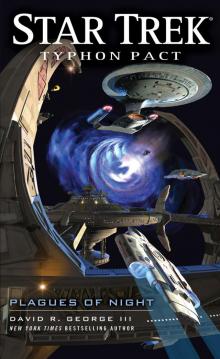 Star Trek: Typhon Pact 06: Plagues of Night
Star Trek: Typhon Pact 06: Plagues of Night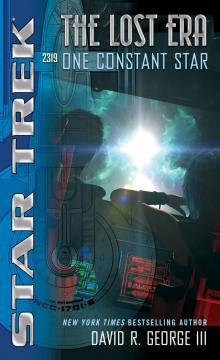 Star Trek: The Lost Era - 08 - 2319 - One Constant Star
Star Trek: The Lost Era - 08 - 2319 - One Constant Star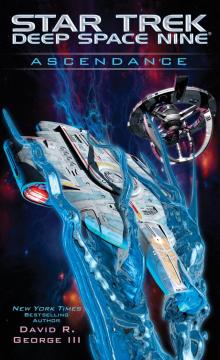 Star Trek: Deep Space Nine: Ascendance
Star Trek: Deep Space Nine: Ascendance Star Trek: TOS: Allegiance in Exile
Star Trek: TOS: Allegiance in Exile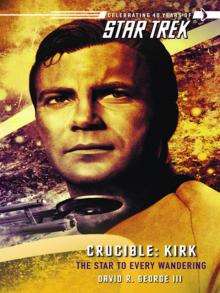 Crucible: Kirk
Crucible: Kirk Crucible: McCoy
Crucible: McCoy The Long Mirage
The Long Mirage Original Sin
Original Sin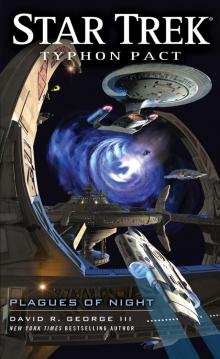 Star Trek: Typhon Pact: Plagues of Night
Star Trek: Typhon Pact: Plagues of Night Allegiance in Exile
Allegiance in Exile Sacraments of Fire
Sacraments of Fire Star Trek: Typhon Pact: Rough Beasts of Empire
Star Trek: Typhon Pact: Rough Beasts of Empire Star Trek: The Fall: Revelation and Dust
Star Trek: The Fall: Revelation and Dust